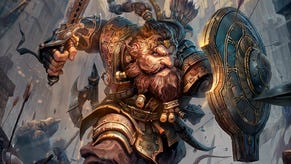John Wick is the perfect movie to inspire your next D&D campaign - and not in its action
How to say just enough.
As well as being a certified banger of an action movie, the first John Wick is a masterclass in subtle, show-don’t-tell world-building and character development - and should be required viewing for every RPG DM looking to establish a gripping, cohesive setting for their players.
(Spoilers for John Wick follow. If you haven’t seen it, you should!)
We’re introduced to Keanu Reeves’ former assassin as a seemingly everyday widower who owns a sweet ride and has a sweet dog left to him by his late wife. When both motor and mutt are suddenly taken away from him, John Wick breaks down the concrete divide he’d put up between his past life and his current one.
Even knowing the identity of John Wick upfront (it’s the premise of the movie, after all), the movie makes its reveal a moment of excitement for the audience - and cold dread for the foes who have unwittingly pissed him off.
“Oh,” is all that Russian mafia boss Viggo Tarasov can utter when informed his son has stolen Wick’s car and killed his dog, before promptly hanging up and staring blank-eyed into the distance. Meanwhile, on the other end of the phone, chop shop owner Aurelio simply takes a large gulp of whiskey.
We know John Wick is a former assassin, but the characters’ often unspoken reactions to his return sets up his presence without resorting to Basil Exposition levels of rattling off Wick’s deadly CV or having him dispatch a room of grunts. It’s a masterclass in establishing a character’s place in the world before we actually see them in action, and something that every GM should take inspiration from for their next roleplaying campaign.
“It’s not what you did that, son, that angers me so. It’s who you did it to,” Viggo explains after beating his confused son. (The scene with Viggo and Iosef offers another gem of world-building through dialogue, as the cocksure gangster coughs out “We did what you asked, no-one saw shit,” after being gut-punched by his dad. “I’m not talking about Atlantic City,” responds Viggo, leaving it at that. The characters already know what they’re referring to, and the audience has been told enough.)
John Wick is a masterclass in establishing a character’s place in the world before we actually see them in action.
“Who, that fuckin’ nobody?” Iosef asks.
“That fucking nobody… is John Wick,” Viggo replies with utmost gravity, before taking a large swig of drink.

What follows is the movie’s incredible setup of John Wick’s “man of focus, commitment, sheer will”, as Viggo recalls his nickname of “Baba Yaga” - ‘The Boogeyman’ - while Wick sledgehammers his way through a concrete office floor.
“John wasn’t exactly the Boogeyman,” Viggo delivers in a grim punchline. “He was the one you sent to kill the fucking Boogeyman.”
“Oh,” Isoef finally clocks, just as his dad has done on the phone. Oh is right, as we’ll soon learn for ourselves. (Not before Viggo gives us a brief tease of what’s to come: “I once saw him kill three men in a bar with a pencil. A fuckin’ pencil!”)
If acting is reacting, reacting here is pure character development. Wick says nothing - his silence continues when Viggo begs him to “handle this like civilised men” via a direct line to his office - but we learn everything we need to know from the way those around him respond. He’s a deadly, almost supernatural force feared by those at the very top of the food chain - and he’s been put on a path of revenge.
“What he’d say?” asks Viggo’s righthand man Avi after Wick hangs up without a word. “Enough,” Viggo says.
In the same way, GMs should say enough through their characters and the way they react to the world and its other inhabitants - no more, no less. A single line of dialogue can be as - if not more - effective in establishing a character as pages of detailed backstory. Even if you have the backstory in mind, you don’t need to recite it all to your players. Not to mention, leaving things somewhat mysterious always leaves the door open for your group to discover more later on if they’re left hooked.

John Wick doesn’t just excel in establishing its title character with lean dialogue and a fully-formed idea of his role in its universe. The movie constructs an entire world and mythology around Wick as he dives back into its gritty underbelly of killers, mobsters and criminals.
A single line of dialogue can be as - if not more - effective in establishing a character as pages of detailed backstory.
At the centre of Wick’s world is The Continental, the hotel for assassins run by Ian McShane’s Winston Scott. As Wick returns to its doors, he uses gold coins retrieved from his buried stash to pay for everything from a room and drinks to weapons and corpse disposal. At no point does anyone explicitly mention that the coins run the economy of the underworld; everyone in the world already knows it, and we discover their importance through their changing of hands.
In the same way, The Continental has an unspoken set of rules. Most, aside from forbidding “business” on hotel grounds, aren’t discussed by the characters. In the first John Wick, we get to see the punishment for breaking its golden rule, as Ms. Perkins is summarily executed for conducting business.

While the later John Wick sequels flesh out the Continental rules around blood oaths and assisting those declared excommunicado in more detail - for better and worse - the first film’s less on-the-nose hints at the wider mythology sketch a fascinating world beyond the one we see on-screen.
Something as simple as establishing “a dinner reservation for 12” as code for disposing of a dozen defeated henchpeople lets the audience in on a clandestine language spoken between assassins - something that a high Culture roll could replicate in D&D by cluing a player character in on similar lingo exchanged between members of a secret society, for instance. Why not have someone in a tavern ask the barkeep for their “finest drop of goblin’s blood”, or a blacksmith reveal a hidden passage when prompted for a sword made of a material that doesn’t exist?
John Wick is a fantastic action-movie spectacle, but its intelligent and measured establishment of its characters and world make it more than just a throwaway romp. If you want your players to remember something beyond how many skeletons they crushed in their latest dungeon-delve, you’d do well to borrow some of its tricks for your next campaign. Now, what’s the stat block for the Boogeyman?










